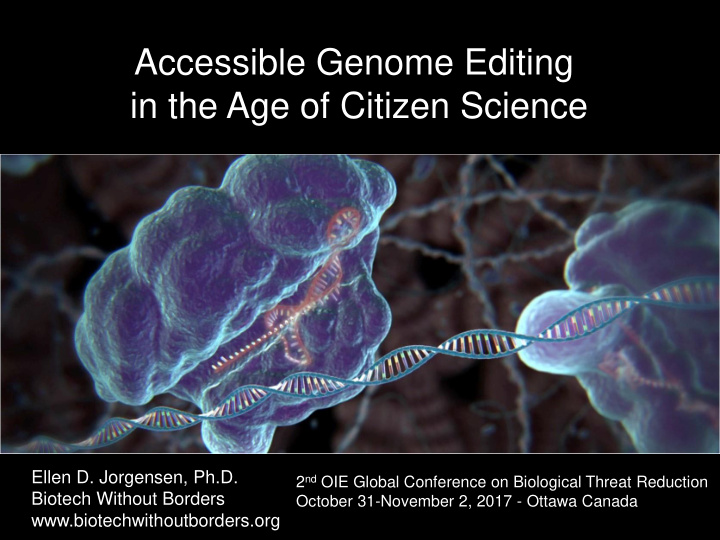



Accessible Genome Editing in the Age of Citizen Science Ellen D. Jorgensen, Ph.D. 2 nd OIE Global Conference on Biological Threat Reduction Biotech Without Borders October 31-November 2, 2017 - Ottawa Canada www.biotechwithoutborders.org
“Central to our mission is the belief that biotechnology and greater public understanding about it has the potential to benefit everyone”
Self-identified DIYbio practitioners
What are Community Labs? • Incorporated as Nonprofits • BSL1 Lab Space open to public • Mission to foster science literacy – classes, talks , workshops • Provide community lab space to facilitate innovation and exploration • Outreach programs for students and adults
Safety/Security Measures • Secure space (keypad entry to building, lockable labs) • Fire extinguishers, eyewash stations, personal protective equipment • Organisms/activities appropriate for BSL 1 (no human pathogens) • Consistent with NIH recombinant DNA guidelines • Minimize hazardous chemical use • Commercial biological and hazardous waste disposal • Safety & equipment training for all members • Scientific Advisory Board available for input
Typical Projects • Food and Environment exploration through DNA Barcoding • Microbial Sampling & Microbiome analysis • Personal genomic exploration • Metabolic engineering of E. coli K12 • Expression of proteins in yeast • Engineering Arabidopsis & tobacco using Agrobacterium tumefaciens • No human or animal pathogens
Biosecurity • Initial meeting with NYC WMD team (FBI-FDNY- NYPD) • Genspace-FBI joint presentations to public • Synbio/FBI Building Bridges • FBI/DIYbio conferences • WMD Basic Training • AAAS multi-agency meetings • Code of Ethics conference • UN WMD Branch, Office for Disarmament Affairs • DTRA meetings
Top Ten Technologies Impacting the UN Sustainable Development Goals 1. Synthetic Biology (high throughput engineering) 2. Improvements in DNA sequencing technologies 3. High capacity DNA synthesis 4. Chromosome building 5. Precise editing of DNA (e.g. CRISPR) 6. Cell-free systems 7. Metagenome and microbiome engineering 8. Tissue engineering (lab grown organs and meat) 9. Improved imaging systems for living organisms 10.Modeling (the virtual cell) Multi-stakeholder Forum on Science, Technology and Innovation for the SDGs New York, 15-16 May 2017
Why is CRISPR Transformative? • “Word processor for genomes” • Relatively cheap and easy to use • Universally useful tech for any process that relies on genetic engineering • Can be precisely targeted in genome with ease, unlike traditional genetic engineering • Increases the accessibility of biotech
Some Uses of CRISPR • Repair genetic disorders (cystic fibrosis, Huntingtons, beta thalassemia) • Reprogram immune system cells to fight cancer (CAR-T therapy) • Greatly increase the speed of development in agricultural genetic engineering (plants and animals) • Decrease antifungal resistance • Embryo editing • Gene drives (engineer a species)
Why use CRISPR in Community Labs? • Common tool to jumpstart innovation • Educate the public about it • Discuss the social, moral and ethical implications of germline editing • Engage around environmental engineering through gene drives (altering or eliminating a species) • Editing embryos is far above the capability of a community lab
Recommend
More recommend